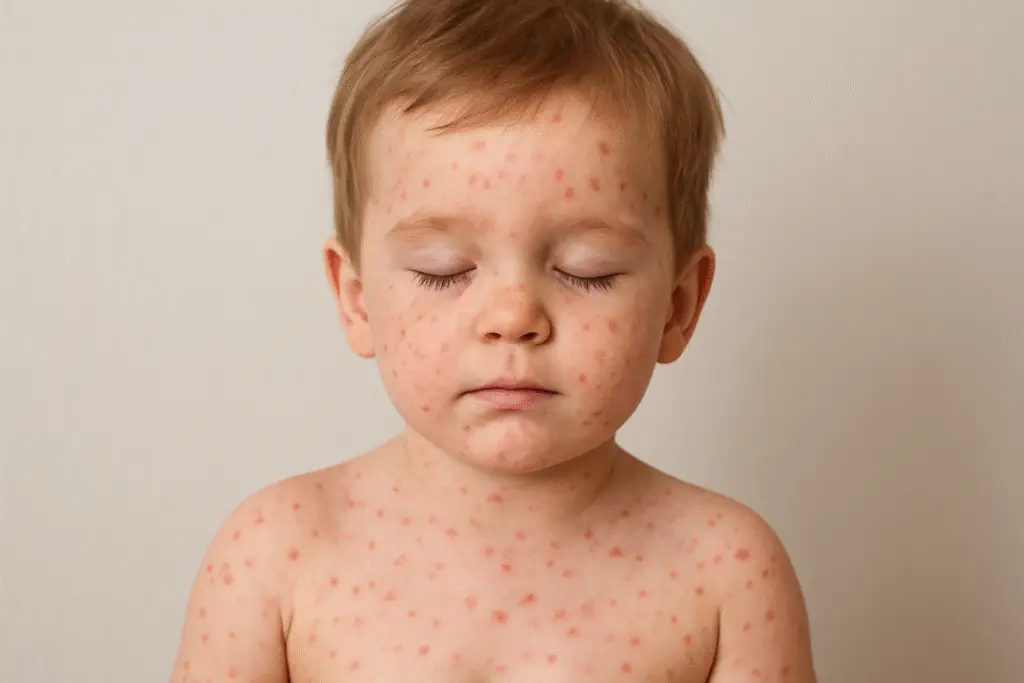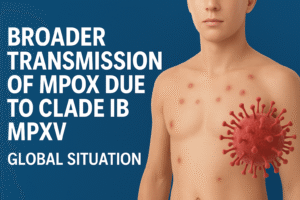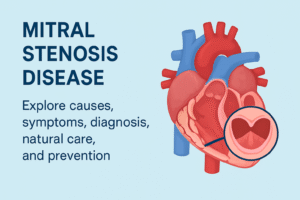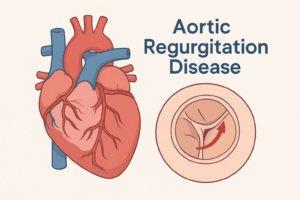Imagine a disease so contagious that one infected person can spread it to 9 out of 10 unvaccinated people nearby. That’s measles. Medically known as rubeola, measles is a highly infectious viral illness that has troubled humankind for centuries.
Even though safe vaccines exist, measles continues to threaten global health. The World Health Organization (WHO) reports that measles remains one of the leading causes of death among young children worldwide—deaths that are largely preventable. In 2022 alone, WHO recorded over 9 million cases and nearly 128,000 deaths, mostly among children under five.
This blog breaks down measles in detail: its causes, symptoms, prevention, natural care, and global impact and why timely medical attention is crucial.
Overview of Measles
Measles is a viral disease that spreads easily through respiratory droplets when an infected person coughs, sneezes, or even talks.
It is often mistaken as “just a childhood rash,” but measles can cause serious complications such as:
- Pneumonia
- Ear infections
- Blindness
- Encephalitis (brain inflammation)
Causes of Measles
The measles virus, a member of the paramyxovirus family, is the root cause. It spreads through:
- Breathing contaminated air
- Touching surfaces where the virus survives up to 2 hours
- Direct contact with the mucus or saliva of an infected person
Stages of Measles Infection
1. Incubation Period (7–14 days)
No visible symptoms. The virus multiplies silently.
2. Prodromal Stage (2–4 days)
- High fever
- Cough, runny nose, red watery eyes
- Tiny white patches inside the mouth (Koplik spots)
3. Rash Stage (3–7 days)
- Red blotchy rash starts at the hairline, spreading downwards
- Fever peaks
- Extreme fatigue and weakness
4. Recovery Stage
- Rash gradually fades
- Lingering cough and tiredness may last 2–3 weeks
Types of Measles
- Classic Measles (Rubeola): Severe and highly contagious
- German Measles (Rubella): Caused by rubella virus, milder but dangerous during pregnancy
Symptoms of Measles
- High fever (above 40°C / 104°F)
- Dry cough & sore throat
- Runny nose (coryza)
- Red, watery eyes (conjunctivitis)
- Koplik spots inside the mouth
- Rash spreading from head to toe
- Fatigue, appetite loss, and body ache
Possible Complications
- Pneumonia
- Ear infections
- Severe diarrhea
- Blindness (linked with Vitamin A deficiency)
- Brain swelling (encephalitis)
When to See a Doctor Immediately
Seek urgent medical help if:
- Fever remains above 40°C (104°F)
- Breathing difficulty or chest pain
- Severe diarrhea with dehydration
- Seizures, unusual sleepiness, or confusion
- Symptoms worsen instead of improving
Professional medical care is non-negotiable in these cases.
Treatment Without Medicine (Supportive Care)
There’s no direct antiviral drug for measles. However, supportive care helps ease symptoms:
- Adequate rest & hydration
- Vitamin A supplements (WHO recommends to reduce severity)
- Light, easy-to-digest meals: soups, porridge, khichdi
- Honey & herbal teas (for adults)
- Steam inhalation to ease congestion
- A dim, quiet room for light-sensitive eyes
Prevention of Measles
The MMR vaccine (Measles, Mumps, Rubella) is the most effective prevention.
- 1st dose: 9–12 months
- 2nd dose: 15–18 months or before school entry
WHO confirms that two doses are 97% effective.
Other preventive steps include:
- Avoiding contact with infected individuals
- Frequent handwashing
- Strong community immunization drives
Healthy Diet for Measles Recovery
Nutrition plays a big role in recovery. Include:
- Vitamin A foods: carrots, papaya, pumpkin, spinach
- Vitamin C foods: oranges, guava, kiwi, bell peppers
- Zinc-rich foods: pumpkin seeds, chickpeas, cashews
- Probiotics: yogurt, kefir, fermented vegetables
- Hydration: coconut water, fresh juices, soups
Avoid oily, spicy, and junk foods that slow down healing.
Risk Factors of Measles
Higher-risk groups include:
- Unvaccinated children & adults
- Infants under 12 months
- Pregnant women
- Malnourished children
- People with weak immunity (HIV, cancer patients)
- Communities with low vaccine coverage
Global Impact of Measles
- 9 million cases worldwide in 2022
- Nearly 128,000 deaths, mostly in children under 5
- Outbreaks even in developed nations due to falling vaccination rates
- International travel spreads the virus across borders
Conclusion
Measles is not just a rash—it is a serious viral illness that can cause life-threatening complications.
WHO research proves that vaccination is the strongest protection, and timely medical care is critical in severe cases. With stronger immunization programs, awareness, and supportive care, the dream of a measles-free future is possible.
FAQs About Measles
Q1: Can measles go away on its own?
Yes, mild cases may resolve in 10–14 days. However, complications can arise, so medical supervision is always advised.
Q2: What foods help recovery?
Foods rich in Vitamin A, Vitamin C, zinc, and probiotics help strengthen immunity.
Q3: Can measles be treated at home?
Only supportive care can be provided at home. There’s no cure—severe cases need professional treatment.
Q4: Who is most at risk of complications?
Unvaccinated children, infants, pregnant women, malnourished children, and people with weak immunity.
Q5: Is measles still common?
Yes. WHO reports millions of cases annually, especially in regions with poor vaccination.
Q6: Can measles be eliminated?
Yes. Through widespread vaccination and strong health systems, measles can be eliminated globally.
At News Armour, we create every article with care, but what makes it truly meaningful is you our readers. Your feedback is not just welcome, it’s what helps us grow and deliver better content each day.
Every suggestion, comment, or thought you share matters to us and shapes the future of this platform. So, let us know what you think because your voice makes all the difference.






